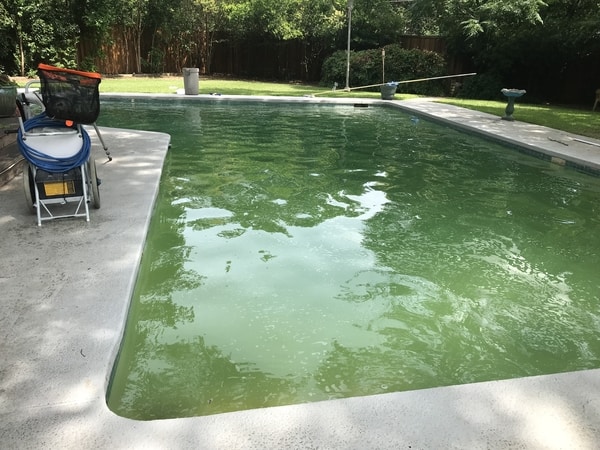
A nice relaxing evening in the pool is a great way to spend time with family and friends, escape the heat, and get some exercise. Algae can easily ruin a day of fun as it provides a potential health risk to the swimmers and the pool itself. It is essential to know the warning signs that your pool has algae and what steps to take to remove it. Here is how to remove algae from a pool:
Symptoms of Algae
It can be hard to distinguish algae and regular dirt in your pool. Being able to recognize the warning signs that your pool is under an algae infestation is the first step in removing algae from your pool. Here are the signs that you need to be on the lookout for.
- Cloudiness
- Slimy pool water
- Discolored water
- Greenish
- Yellow
- Blueish-black
- Stains around the stairs, corners, pool walls, jets, and skimmers
Algae Removal Steps
Now that you have determined that your pool indeed has algae. It is time to take action and remove the pest out of your pool so you can return to enjoying your pool’s many benefits.
1. Vacuuming
You will need to get as much of the algae out of your pool as possible before going through with the actual treatment. This will help prevent you from missing a spot resulting in regrowth of algae. To get rid of a good chunk of the algae, you will want to vacuum as much of it as you possibly can. A lot of pool owners today have an automatic or robotic vacuum for their pool. While this is effective on normal pool dirt, it has little effect on algae. You will want to use a manual vacuum cleaner.
Make sure you vacuum the waste to ensure that contaminated water doesn’t recirculate into your pool. Next, focus on vacuuming the walls and floor of your pool. Pay particular attention to any shady spots, as algae are sure to grow the strongest in these areas and can be harder to spot.
2. Brush Your Pool
You will then need to scrub the algae off of your pool walls. This helps stirs up the sediment so it can be killed later on and filtered out. A stiff pool brush on a long pole will help you get the floors and hard to reach the walls of your pool. Pay extra attention to the corners and shady spots of your pool, as the algae will be the worst in these areas. It may be worth it to get the corners and shady spots first, as the water will get cloudier as the algae are forced off of the walls, making it harder to see.
3. Test and Balance the Water
You will need to test the balance of your pool water to get the correct alkalinity and pH. This can be accomplished by using test strips, a digital kit, or a liquid kit. The alkalinity of your pool is extremely important, as it tells you the chemical measurement of the water’s ability to neutralize acids, which is key in killing the algae. A high pH and low alkalinity will make the pool shock treatment ineffective.
4. Shock Treatment
A calcium hypochlorite shock treatment will help destroy the algae. You will need to follow the packaging instructions carefully to get the proper dose for your shock treatment. Here are the standard times of shock treatment that need to be done to your pool based on the type of algae you have.
- Green Algae needs two shock treatments
- Yellow or dark green algae needs 3 shock treatments
- Black algae need 4 shock treatments
It is essential that you do not use stabilized chlorine to shock your pool. You will end up with too much cyanuric acid. This will inhibit the sanitizer and lead to more algae to grow.
During the shock treatment, it may be worth it to throw your cleaning equipment in the shallow end of the pool, this will help sanitize the tools and reduce the risk of future contamination.
5. Filter Out the Dirty Water
A successful shock treatment will leave your pool water cloudy with a bluish hue. You will need to run your pool’s filter continuously for 8 hours to allow the water to clear up. Make sure that your pool has enough water to run the pump safely. For quicker results, you can add in some pool water clarifier.
6. Test The Water Chemistry a Second Time
You need to make sure that your pool’s water chemistry is balanced. Once your tests show that the chlorine levels are back to normal and your pool’s chemistry is properly balanced, you can allow family and friends to use the pool. Do not allow them to use the pool before this step is done, unbalanced pool chemistry can be toxic to humans.
7. Clean Out the Filter
A deep clean of your filter will help reduce the possibility of recontamination. You can clean it by soaking it in diluted muriatic acid. This should kill any remaining algae and leave your filter nice and clean. If you are uncomfortable using this acid or worried about recontamination, you can also get your pool filter replaced.
Once you have completed all of the steps, you can rest easy and know that your pool is clean and safe for use. You shouldn’t have to worry about algae ruining your summer. Algae can be prevented with a routine maintenance service from Liquidus Pool Services. Contact our pool experts today to see how we can help you enjoy the most out of your pool.
